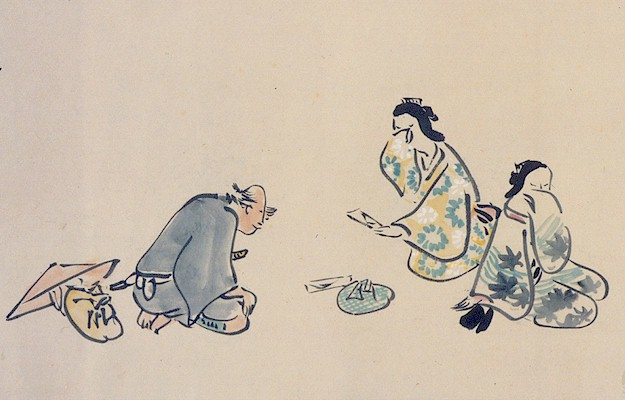Society for Asian Art, Literature Courses, Fall 2013
Haiku and Haiga: The Writings and Paintings of Edo Period Japanese Masters
Instructor: John Wallace

Sundays 10:15-12:15 / Asian Art Museum of San Francisco
Matsuo Bashō (1644-1694), considered the greatest haiku master of Japan, also painted. Yosa Buson (1716–1784) is considered by many as the next greatest of haiku poets, but he is also known as a haiga (painting with haiku) master. Haiga is a casual style of painting that includes a haiku next to the image that relates in some way to the image. We will read and discuss Bashō's haiku, read his great prose work Narrow Road to the Deep North, and appreciate his haiga. Buson was key to the "Bashō Revival" movement and we will keep this in mind as we consider his haiku and lovely haiga. Kobayashi Issa (1763–1828) is the other preeminent haiku master of the Edo period. Time permitting, we will consider some of his excellent haiku as well.
We had a poem sequence submission shortly after this class was completed. I am posting it below. It is wonderful.
Frequently I go down the Peninsula to visit my sisters, both of whom have health issues. One lives in an assisted living facility and the other lives at home with two of her adult children. When I am there, I sleep on an air mattress in the latter's living room which is rarely used. In the wee hours of the morning on October 19, 2013, I woke up thinking about the Haika and Haiga class with John Wallace. My thoughts were that we might have to write something and my mind proceeded to compose a short verse inspired by Basho's and Buson's writings. I went back to sleep vowing to remember the words and to write them down when I would get up. When I did write down the words to "In winter...," I decided it was too long, so I rearranged it. Upon reading the second verse, I felt it couldn't stand alone so I should try to complete the seasons. When I finished, it became "The Tree of Life."
I usually prefer to be anonymous, but I feel I should own this.
Jean Devich
Tree of Life
- In Winter, the leaves wither and fall exposing the branches of the tree,
Just as the faces of the aged show the branches of life.- In Winter, the exposed branches of the tree,
Are as the branches of life on the faces of the aged.- In Spring, the branches of the tree sprout,
As the child comes from the womb.- In Summer, the leaves hide the branches of the tree,
As the young grow.- In Fall, the branches of the tree are full of color,
As the adult flourishes.